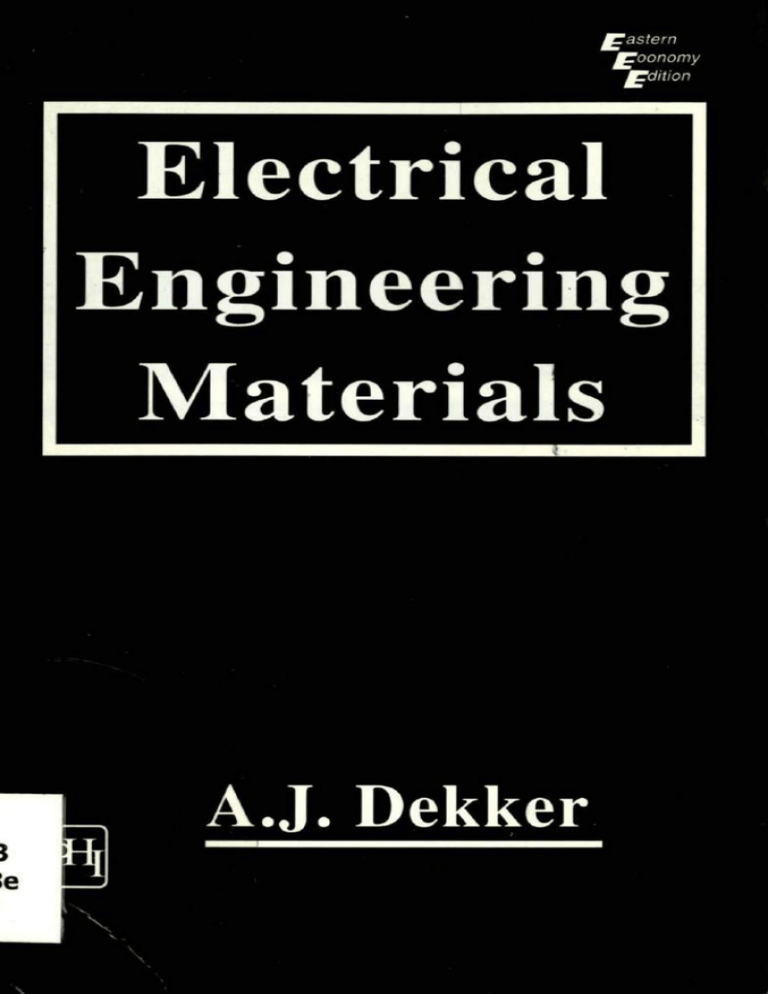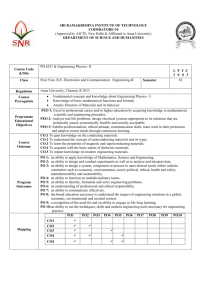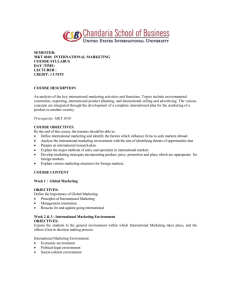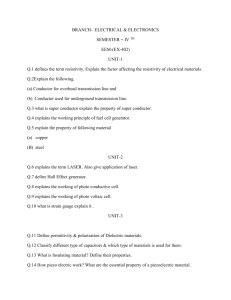EasternEoonomyEdition Electrical Engineering Materials
advertisement

EasEoonomy tEdiertnion Electrical Engineering Materials 11 A.J. Dekker Electrical Engineering Materials PRENTICE-HALL ELECTRICAL EN'cI:INEEflJNG SERIES W. L. EvERITT, Ph.D., Editor Elements of Television Systems Network Synthesis BENEDICT introduction to industrial Electronics DAVIS AND WEED industrial Electronic Engineer;ng Di.iKER Electrical Engineering Materials EVANS Experiments in Electronics Frr Feedback Control Systems FicH Transient Analysis in Electrical Engineering FicH AND POTTER Theory of A-C Circuits COLOMAN information Theory GOLDMAN Transfos motion Calculus and Electrical Transients HEBSIIBERGER Principles of Communication Systems JORDAN Electromagnetic Waves and Radiating Systems Lo, ENDERS, ZAWELS, WALDHAUER, AND CLIENO Trnistor Electronics MARTIN Elecru,ic Circuits MARTIN Phy.ieal Basis for Electrical Engineering MARTIN Ultrahigh Frequency Engineering MOSKOWrTZ AND R.&cxR Pulse Techniques NIXON Handbook of Laplace Transformation: Tables and Examples NIXON Principles of Automatic Controls PARTRIDGE Principles of Electronic Instruments PIYMPEREY Electrical Engineering, 2d ed. PUMPUREY Fundamentals of Electrical Engineering, 2d ed. REED Electric Network Synthesis RIouT Active Networks RYDER Electronic Engineering Principles, 3d ed. RYDER Electronic Fundamentals and A pplications, 2d ed. RYDER Networks, Lines, and Fields, 2d ed. SsEuD Fundamentals of Electromagnetic Waves SE.EODER AND HELM Circuit Analysis by Laboratory Methods, 2d ed. SooHoo Tfr'ory and Application of Friite Srotrr Basic Electrical Measurements, 2d ed. TII0MBON Laplace Transformation, ?d ed. VAIL Circuits in Electrical Enginrerin(i VAN DER ZIEL Noise VAN DER ZIEL Solid State Physical Electronics VAN VALEENBIJEG Network Analysis VON TERSCH AND SWAGO Recur,eni Electrical Transients WARD Introduction to Electrical Engineering, 3d ed. WAFIzLD Introduction to Electronic Analog Computers WEED AND DAVIS Fundamentals of Electron Devices and Circuits AER BAL-BANI ELECTRICAL ; ENGINEERING MATERIALS ADRIANUS J. DEKKER PtIOf<SSOR, [)£P"-RTMENT Of ElEcnlCN. ENGINEERING INSTITUTE Of TECHNOlOGY UNIVERSITY OF MINNESOTA PrenticelHall of India ~[j~w®~@ IlJlfiITI~~®@J New Delhi - 110 001 This Twentieth Indian Reprint—Rs. 12000 (Original U.S. Edition---Rs. 655.00) ELECTRICAL ENGINEERING MATERIALS by A.J. Dekker ,0 1959 by Prentice-Hall. Inc., Englewood Cliffs, N-J, U.S.A. All rights reserved. No part of this book may be reproduced in any form, by mimeograph ot any other means, without permission in writing from the publisher. ISBN-81-203-0080-7 The export rights of this book are vested solely with the publisher. This Eastern Economy Edition is the authorized, com plete and unabridged photo-offset reproduction of the latest American edition specially published and priced for sale only in Bangladesh, Burma, Combodia, China, Fiji, Hong Kong. India, Indonesia, Laos, Malaysia, Nepal, Pakistan. Philippines, Singapore. South Korea, Sri Lanka, Taiwan, Thailand, and Vietnam Reprinted in India by special arrangement with Prentice-Hall, Inc., Englewood Cliffs, N.J., U.S.A. Twentieth Printing ,2008 Published by Asoke K. Ghosh, Prentice-Hail of India Private Limited, M-97, Connaught Circus, New Delhi-I10001 and Printed by Tarun Offset Printers, New Dethi-110064. Preface It might be said justifiably that the curriculum offered In most electrical engineering departments has changed a good deal during the last five or ten years. In our own department, for example, there has been an increasing emphasis on the teaching of fundamental concepts rather than more specialized subjects. This is true particularly of the first four years of our five-year undergraduate curriculum, the fifth year being reserved for the discussion of the specialized areas. Running parallel with this tendency there has been an increasing emphasis on a sound background in physics and mathematics. Another aspect of the changes in the curriculum involves the increasing importance of the science of materials, which has led to a number of new devices used in present-day electrical engineering, and which will probably become even more important in the future. In our own department this has resulted in a gradual filtering-down of subjects such as electron physics and "molecular engineering" from the graduate level to the undergraduate level. Thus, a few years ago an elective course in the fifth year of the undergraduate program was introduced in which the operation of solid state devices is discussed along the lines of A. van der Ziel's book ,Solid State Physical Electronics (Prentice-Hall, Inc., 197). More recently, the faculty of our department decided to go one step further in this direction by offering a new course to be taken by all electrical engineering students in their fourth year. The course was to run for only one quarter, at least to begin with, and its purpose was to introduce the students to the physical interpretation of the dielectric, magnetic, and conductive properties of materials without entering into the actual applications. This book is a modest attempt to provide material for a course of this kind. It is limited in scope, but the subjects discussed would seem particularly suitable for a course aimed at giving the students some idea of the methods and models employed in the study of materials of interest V Vi Preface to the electrical engineer. Also, I hliev that it is more usciul for a student to have absorbed a certain amount of knowledge about a limited number of subjects than to have been exposed to a great variety in a hurry. Since most undergraduate electrical engineers have no working knowledge of wave mechanics, no attempt has been made to introduce quantum mechanical concepts, except in a passing manner. This may disappoint some of my collea ues, who will point out that one can introduce wave mechanics by qualitative argu(nents. However, I am not convinced that the student.- will benefit gretiv from such arguments at this level unless they have acquired a certnln degree of maturity in handling classical problems. Thus, the models used in this book are essentially classical or semiclassical. I feel that the lack.of rigor implied by these models is outweighed by their usefulness in providing the student with a reasonable amount of insight into the physical mechanisms which underlie the properties of materials. I have also found that these models provide good exercise for the student, to which he can apply his knowledge of elementary field theory. Although it is not necessary to adhere to the order in which the subjects are discussed in this book, it would seem desirable to have dielectrics precede magnetics; on the other hand, one may well discuss all or part of the last three chapters on conduction in metals and semiconductors before one deals with dielectric and magnetic properties. A list of general references is given at the beginning of this book, whereas references to specialized topics can be found at the end of each chapter. In general, I have limited the references to representative books or review articles. A set of problems has been given at the end of each chapter. In a number of cases these problems are intended to supplement the text. I have refrained from giving many problems which merely require application of the slide rule. However, a number of numerical problems have been included to give the student a feeling for the order of magnitude of the quantities which enter into the discussion. Answers to the problems are provided at the end of the book; a table of frequently occurring physical constants may be found at the beginning. Throughout this book, the mks system of units has been used. I wish to express my appreciation to Dr. W. G. Shepherd for his encouragement before and during the preparation of the manuscript, and to Dr. K. M. van Vliet for valuable discussions and for reading a large part of the manuscript. A. J. DBKXER Contents 1. Atoms and Aggregates of Atoms 1 I 1.1 Introduction ........... .. and new quantum 1.2 The hydrogen atom according to the old mechanics ............. ..... . . . . . . 7 1.3 Nomenclature pertaining to electronic states .......S .. 1.4 The electron configuration of atoms ......... of 1.5 The nature of the chemical bond and the elasificatiofl 10 solids ............. 15 1.6 Atomic arrangements in solids ............ 2. Dielectric Properties of Insulators in Static Fields 23 ............ 24 2.1 The static dielectric constant 26 2.2 P o larization and dielectric constant ........... 2.3 The atomic interpretation of the dielectric constant of mono28 ..... ........ atomic gases .......... ... nstant polyatotniC of on the dielectric co .31 2.4 Qualitative remarks molecules ........................ .poly constant Of 2.5 Quantitative discussion of the dielectric35 atomic molecules ............ ... 40 2.6 The internal field in solids and liquids .... .. .. .. .. .. 2.7 The static dielectric constant of solids ........ 2,8 Some properties of ferroelectric materials . ntaneous polarization ............ 2.9 S po 2.10 Piezoelectricity ...........56 Behavior of Dielectrics in Alternatin g Fields 62 3.1 Frequency dependence of the electronic polarizabilitY , 3.2 Ionic polarization as a function of frequency .......66 67 3.3 The complex dielectric constant of non-dipolRr solids 69 3.4 Dipolar relaxation ............73 3.5 Dielectric losses ........... 'Ii 62 viii Contents 4. Magnetic Properties of Materials 79 Pare I. Preparatory Discussion 4.1 Summary of concepts pertaining to magnetic fields 4.2 The magnetic dipole moment of a current loop 4.3 The magnetization from a macroscopic viewpoint . 4.4 Orbital magnetic dipole moment and angular momentum of two simple atomic models ................ 4.5 Lenz's law and induced dipole moments 79 82 84 88 90 Port H. Atomic Interpretation of Magnetic Properties of Materials 4.6 Classification of magnetic materials 4.7 Diamagnetism .................... 4.8 The origin of permanent magnetic dipoles in matter . 4.9 Paramagnetic spin systems .............. 4.10 Some properties of ferromagnetic materials ....... 4.11 Spontaneous magnetization and the Curie-Weiss law 4.12 Ferromagnetic domains and coercive force ........ 4.13 Antiferromagnetic materials .............. 4.14 Ferrimagnetic materials ................ 97 99 100 104 108 110 114 115 120 5. The Conductivity of Metals 124 5.1 Ohm's law and the relaxation time of electrons ......12h 5.2 .Relaxation time, collision time, and mean free path. . 129 5.3 Electron scattering and the resistivity of metals .....133 5.4 The heat developed in a current-carrying conductor . . . 137 5.5 The thermal conductivity of metals ..........138 5.6 Superconductivity .................. 6. The Mechanism of Conduction in Semiconductors 6.1 Classifying materials as semiconductors ......... 6.2 The chemical bond in Si and Ge and its consequences. 6.3 The density of carriers in intrinsic semiconductors; the energy gap ...................... 6.4 The conductivity of intrinsic semiconductors 6.5 Carrier densities in n-type semiconductors ........ 6.6 p-type semiconductors ................ 6.7 Hall effect and carrier density ............. 151 151 153 156 160 161 168 169 Ccrnte.ts ix 7. Junction Rectifiers and Transistors 174 174 7.1 I\Iinority and majority carrier den.sities in semiconductors 176 7.2 Drift currents and diffusion currents; the Einstein relation 177 7.3 The continuity equation for minority carriers • 180 7.4 Semi-quantitative discussion of the n-p junction rectifier 7.5 Quantitative treatment of the n-p junction rectifier ....184 189 7.6 Thickness and capacitance of the junjion barrier . . junction transistor .............193 7.7 The n-p-n Answers to Problems Index 199 203 General References A. J. Dekker, Solid State Physics, Prentice-Hall, Englewood Cliffs, N. J., 1957. C. Kittel, Introduction to Solid Slate Physics, Wiley, New York, 2nd ed., 1956. T. L. Martin, Jr.. Physical Basis for Electrical Engineering, Prentice-Hall, Englewood Cliffs, N. J., 1957. D. C. Peaslee and H. Mueller, Elements of Atomic Physic8, Prentice-Hall, Englewood Cliffs, N. J., 1955. M. J. Sinnott, The Solid State for Engineers, Wiley, New York, 1958. A. van der Ziel, Solid State Physical Electronics, Prentice-Hall, Englewood Cliffs, New Jersey, 1957. C. Zwikker, Physical Properties of Solid Materials, Interscience, New York, 1954. J. E. Goldman, ed., The Science of Engineering Materials, Wiley, New York, 1957. Approximate Values of Physical Constants Avogadros number Boltzmann's constant, Electric conversion factor, Electronic charge, e Electron rest mass, m Loschmidt's number Magnetic conversion factor, Mo Planck's constant, h Proton rest mass Velocity of light, c 1 Bohr Magneton, = eh/4i-m 1 Debye unit k 6.0254 X 10 23 per gram molecule 1.380 >< 10 joule degree-' 8.854 >< 10_ 12 farad meter-1 - 1.601 X 10" coulomb 9.107 X 10 11 kilogram 2.687 x 10' meter 41r X 10 = L257 X 10 henry meter-' 6.624 X 10 joule second 1.672 X 10 27 kilogram 2.998 X 10 8 meter second 9.27 X 10_ 24 ampere meter2 3.33 X 10- 0 coulomb meter



